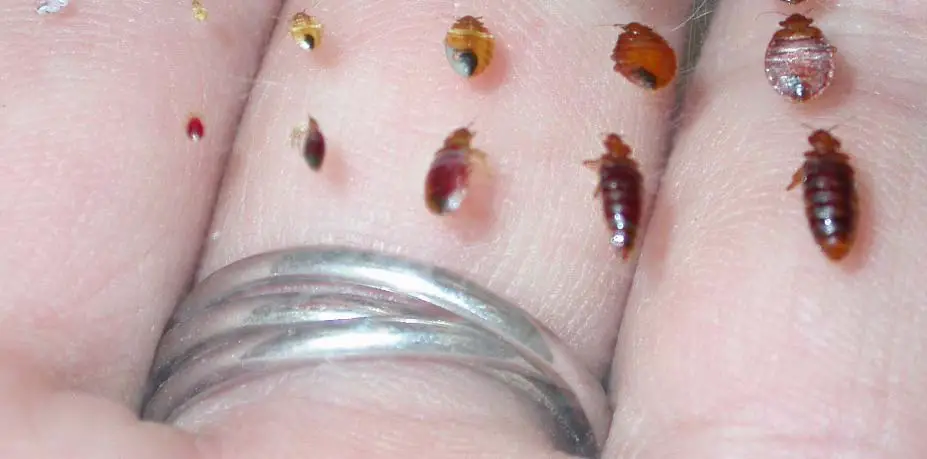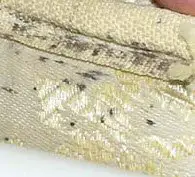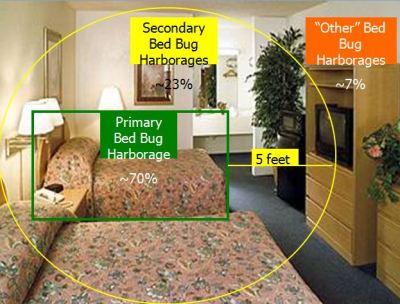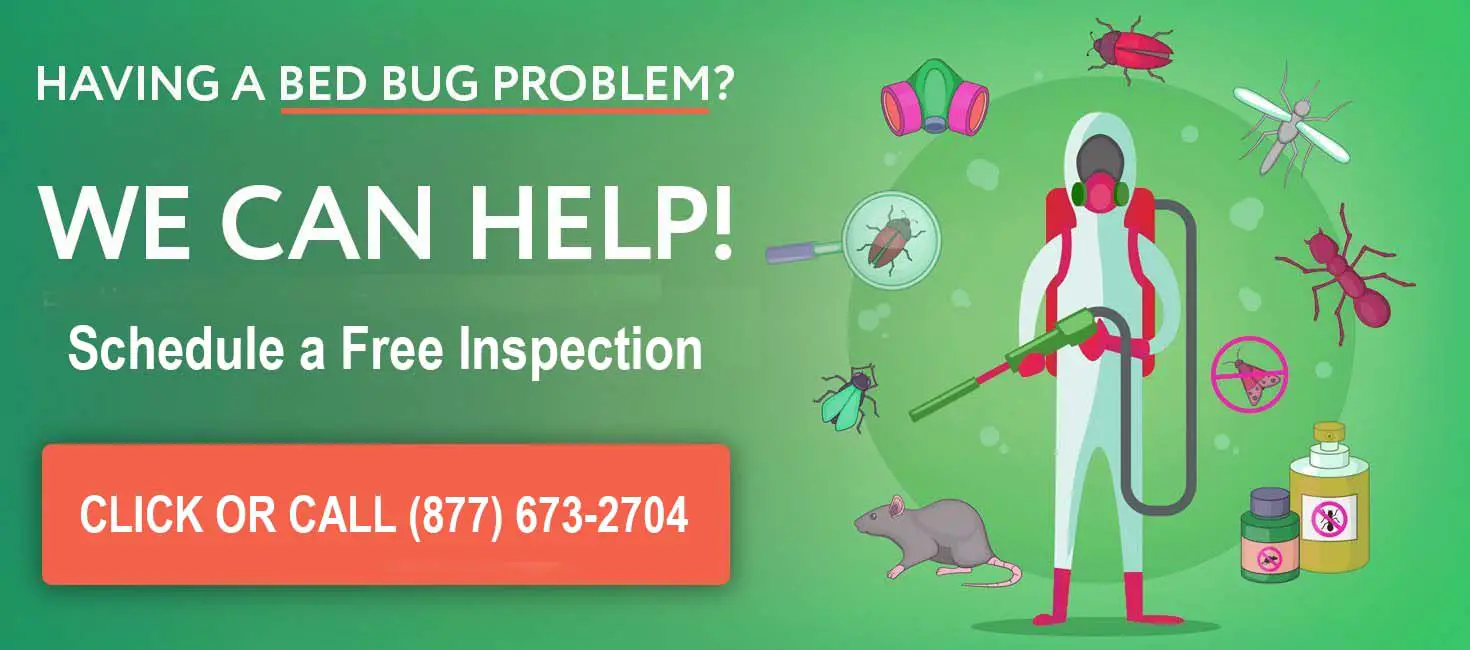" Facts about bed bugs including information on identification, bites, and treatment methods. Bed bug infestations are considered to be the toughest to treat among all insects. If you have a bed bug problem, the first step should be to call in an exterminator or take a sample to a cooperative extension for confirmation. Then follow the steps outlined below."
Bed Bug Identification
Bed bugs (C. lectularius) start in an egg and then pass through 5 infant life stages (called instars) followed by the 6th stage which is when a bed bug becomes an adult. A baby bed bug is referred to as a nymph. As they move through each life stage they shed their skin. A blood meal is needed to move from stage to stage.
Bedbug eggs are pear shaped and white. They can be seen with the naked eye, although a magnifying glass and flashlight help as eggs are about the size of a poppy seed. They adhere to the surface with a cement like substance.
After hatching a nymph is about the size of the head of a pin.
Nymphs are straw colored with all bed bugs changing in appearance as they move through the life cycle. Adult bedbugs are 1/8 - 3/16 inches (4-5mm) long and are red/brown in color. They body is oval shaped.
 The insects change in appearance at each stage of the life cycle plus before and after feeding. They are covered with short yellow hairs and can be seen with the naked eye
The insects change in appearance at each stage of the life cycle plus before and after feeding. They are covered with short yellow hairs and can be seen with the naked eyeThe parasites feed on people and warm blooded animals. Pets includes cats, dogs and birds. They will also feed on rodents.
The insects have vestigial wings (non functioning) and cannot fly or leap onto a host. They most at about the speed of an ant over ceilings, floors and other surfaces. They will travel up to 100 feet in search of a host.
A female bed bugs can lay up to 300 - 500 eggs in her lifetime, and look for a secluded area. She will lay 3 to 5 per day. A bed bug can move through its life cycle in as little as a month (typically 4 to 5 weeks), depending on temperature. The ideal temperature is 70F-90F for bed bug development. Typically, they will move through 3 generations in a year.
Bed bugs can survive for months without feeding, with nymphs (baby bed bugs) surviving for up to 3 months. Get bed bug help from a professional if the problem persists.
They will feed at night and hide during the day unless disturbed or under stress.
how bed bug problems spread
Bed bug infestations spread when bedbugs are carried from one place to another. They hitch a ride on luggage, used furniture and the bags of returning college students. Where ever there are people, there can be bed bugs.
In New York City they have been found in clothing stores and subways. Across the country they are turning up in college dormitories and hospitals. It has little to do with socio-economic status, but more likely correlated with travel.
Studies show that bed bugs can spread from apartment to apartment. There is a 7% chance that they will spread to an apartment over or below the infested room, and a 20% chance that they will spread to an adjacent apartment.
how infestations feed
A bedbug doesn't actually bite, but punctures the skin through a hollow tube called a stylet. They pierce the skin looking for a vein or capillary to eat. They will feed for 3 to 10 minutes and then return to their hiding place until ready for the next meal.
People do not feel the bed bug bite or can tell when a bed bug is feeding on the skin. Bed bugs can carry disease pathogens (up to 20 human diseases), but do not spread disease. Recent studies of bed bugs in hospitals show that patients that were bitten in the hospital have a higher incidence of the MRSA skin infection.
Bed Bug Bite Symptoms
Most people show no skin reaction to the bed bug bite. Those that do have a reaction can see one within an hour to as long as 14 days later.
Mild bed bug bites range from a single red papule to groups of papules. Bed bugs primarily bite areas that are exposed during sleep. They will also bite under loose fitting clothing. Unlike other insect bites that have a red center, bed bug bites have a clear center.
 Bites are an allergic reaction that is different from person to person. They can be individual or found in groups on areas of skin that are accessible to the insects when the host is asleep.
Bites are an allergic reaction that is different from person to person. They can be individual or found in groups on areas of skin that are accessible to the insects when the host is asleep.Bed bug Signs
Bedbugs hide in tight spaces about the width of a credit card. They leave marks such as brown/black feces, skins and stains. Eggshells from hatched bed bugs and the eggs themselves are also signs of a bed bug infestation.
They do sometimes leave a raspberry type odor, but it is not always present. Dogs are able to be trained to sniff out bed bugs at all times, an approach which is 98% accurate.
what to do when you have an infestation
First confirm that your building has bed bug infestations by bringing a sample to a local cooperative extension or ask the building to show a sample to a local pest control expert. Baby cockroaches and other insects look like bedbugs, so look for other signs such as mattress stains to confirm that you have a bed bug problem.
 Check the mattress if you suspect bedbugs. Signs include brown/black spots along the seams. Run a wire brush in the seam and seem if you jar loose any insects, which you can see with the naked eye
Check the mattress if you suspect bedbugs. Signs include brown/black spots along the seams. Run a wire brush in the seam and seem if you jar loose any insects, which you can see with the naked eyetreatment Advice for Apartment Owners
If you live in an apartment, be sure to call the building management. Don't be surprised if the building refuses to pay for bed bug treatment, as it is not covered by most landlord tenant agreements. If they refuse to pay, consider applying pressure on the management company by:
- Organizing tenants
- Contacting the local health department
- Ask the help of a local politician
- Contact the media and let them know about the buildings bed bug problem
- Contact a local pest management company
Advice for Home Owners
If you live in a home, then call pest management at the first sign of trouble instead of doing it yourself. We suggest starting with Home Advisor or call eLocal for a recommendation at (877) 673-2704. Compare quotes to firms you find in our bed bug exterminator database.
Bed bug treatment can cost from $50 several hundred dollars for the in-home inspection and over $1,000 for the treatment itself. Because of the high cost, it pays to get several quotes. Also, companies vary in levels of experience, written guarantee, time period the guarantee covers and bed bug solutions used.
To save money and if your infestation is smaller and confined to one room, you can purchase a home bed bug kit. A kit is essential as multiple products are needed for a complete bed bug solution. These include bed bug sprays, powders/dust and a hand steamer.
What You can Do to treat your problem
- Dispose of clutter, this minimizes the number of hiding places. This includes newspapers, toys, magazines etc.
- Wash all bedding in hot water. Dry clean any items that can't be washed.
- Use the vacuum crevice tool and vacuum the mattress, box spring, floors, head board and along the baseboard. Be sure to vacuum inside the box spring.
- Steam the mattress and box spring with a hand held steamer. Steam clean carpets as well. Larger bed bug infestations may require removal and possibly disposal of the carpet.
- Treat all items with sprays starting with the knock down spray, followed by the residual spray.
- Cover the mattress and box spring.
See this page on bed bugs treatment for detailed instructions on how to get rid of bed bugs by yourself.
Hiding Spots
If a bed bug infestation is in the bedroom, studies show that most insects will be hiding as close to the host and bed (70%) as possible. A study by the University of Kentucky found 35% of the insects in the box spring, followed by the mattress (22%), frame/headboard (13%), nightstand/dresser.
 Hiding places are usually within 5 to 20 feet of the infested area
Hiding places are usually within 5 to 20 feet of the infested areaBed bugs usually can be found in, on, or behind most pieces of furniture. They can live outside of the bed room, they usually migrate and hide in areas where people congregate in their homes such as couches, sofas and reclining chairs.
About 7% of bed bugs in a typical home or apartment are found in the walls and ceilings. Be sure to check sleeping areas, around electrical outlets, underneath lamps, behind wallpaper and in and under drawers.
No professional can find and treat every bed bug. It may take several treatments and a combination of products to do the job. For example, one bed bug spray is needed to kill bedbugs and eggs on contact to reduce or knock down the size of the bed bug infestation, while another spray is needed for lasting protection.
In apartments, bed bug problems often return when tenants fail to allow multiple treatments, leave clutter that blocks treatment, or picks up bed bugs and brings them home.
Insecticide Resistance
Several strains of bed bugs are showing resistance to some insecticides. Even DDT, a now banned and once effective insecticide will no longer work against today's bed bugs in most North Eastern cities.
Products that have been independently tested by the University of Kentucky that show no bed bug resistance include:
- Pump Spray: Sterifab (mattress safe)
- Aerosol: Bedlam (primarily a knock down spray that kills on contact)
- Aerosol: Phantom (use along with Bedlam for protection that lasts several weeks)
Note that Phantom is not available to New York residents. Both Sterifab and Bedlam are mattress safe. A good organic spray alternative to these insecticide baaed products is Bug Patrol.
Other tools for bed bug removal include the vacuum (crevice tool is helpful), and a hand steamer. A steamer generates the 113F necessary to kill the insects. Multiple steam treatments can significantly reduce the size of bed bug infestations.
Professionals have tools not available to homeowners such as fumigation, portable heaters (called thermal remediation), and freezing sprays (carbon dioxide spray). They are also licensed and trained to handle pesticides.
You can acquire your own portable heater and set the room above 122 degrees Fahrenheit, anything above 120 degrees is lethal towards bed bugs.
Are Bed Bug Encasements Necessary?
It is very easy to miss bedbug eggs and the insects themselves during treatment. The eggs are often glued to the foam padding inside the box spring.
If a mattress and box spring is in good condition, if is preferable to use a mattress and box spring cover instead of throwing out the mattress/box spring set. This is used after treatment to trap any bed bugs and late hatching bed bugs that might have been missed during treatment. Encasements must specifically state that they are bed bug proof. If they are not, it is likely that bed bugs can escape through the zipper.
Pillows should be thrown out. They can also be protected in bed bug pillow covers.
Note that encasements do not keep bed bugs off of the person sleeping, they only keep the bed bugs from hiding in the mattress/box springs. If you do not have bed bugs, but want to protect the mattress, then encasements will provide the needed protection.
How long do you have to stay out of your home after preventive treatment for bed bugs?
Most treatment methods allow homeowners to enter their home right after an exterminator is finished working using an insecticide, heat treatment, or freezing spray. Do not use bed bug bombs as these are not effective since they just cause the insects to hide in the walls only to return later.
Does Medicare pay for bed bug pest control how many times a year?
Some Medicare Advantage plans will pay for pest control. Call you plan advisor for additional information as to whether your infestation is large enough to qualify under our plan.
Ask a Question or Share Your Bed Bug Experience With Others
Do you have a question or great story about bed bugs? Share it!

